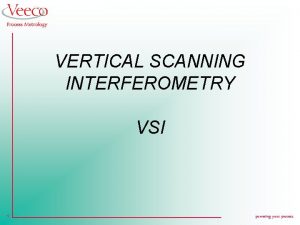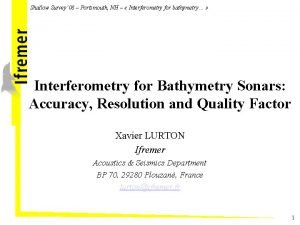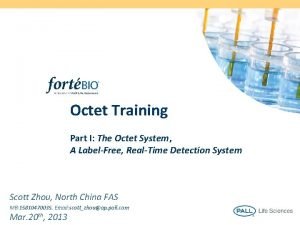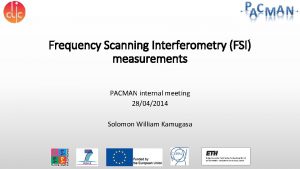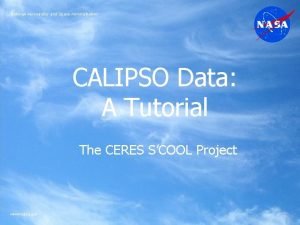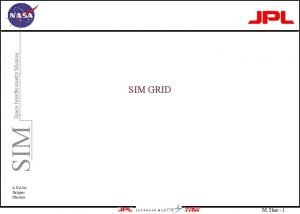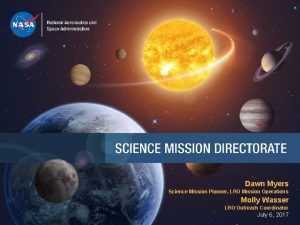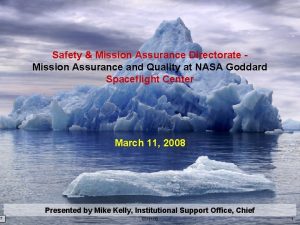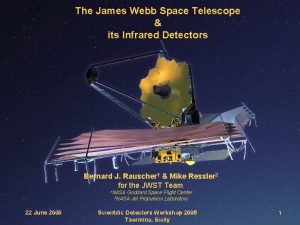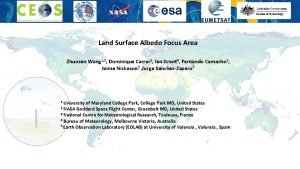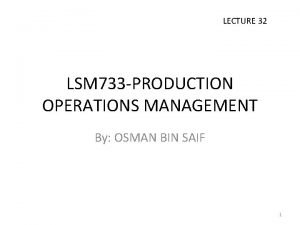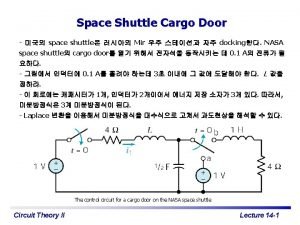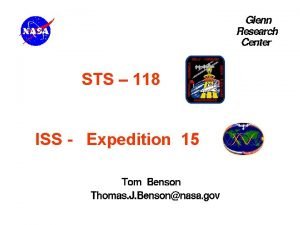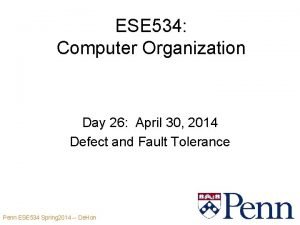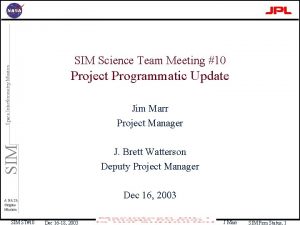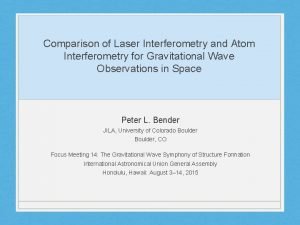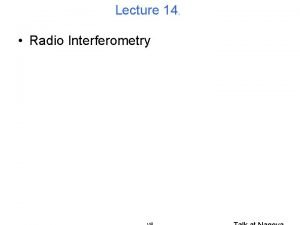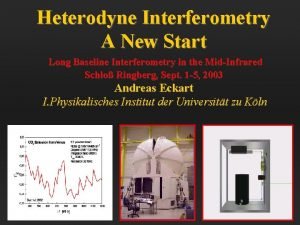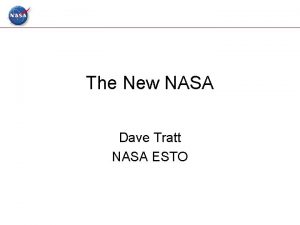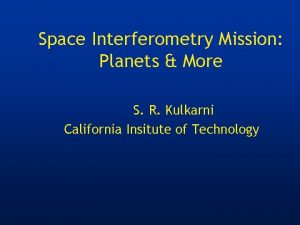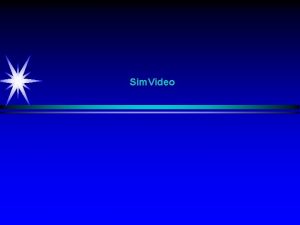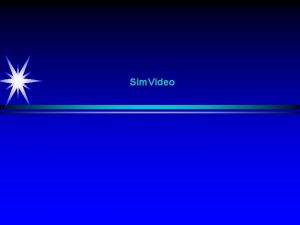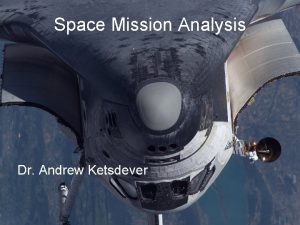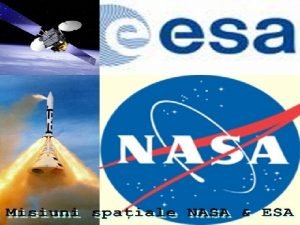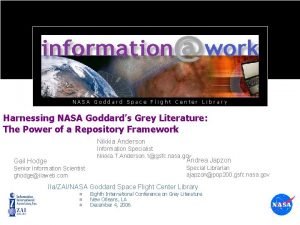SIM Space Interferometry Mission SIM GRID A NASA






![• 3% of G stars have planets with 0. 3 < log[period(days)] < • 3% of G stars have planets with 0. 3 < log[period(days)] <](https://slidetodoc.com/presentation_image/5fc8e4f113a43f8ac354af6d071590ff/image-7.jpg)
![• Assume planet population with 0. 3 < log[ period(days) ] < 5 • Assume planet population with 0. 3 < log[ period(days) ] < 5](https://slidetodoc.com/presentation_image/5fc8e4f113a43f8ac354af6d071590ff/image-8.jpg)











- Slides: 19

SIM Space Interferometry Mission SIM GRID A NASA Origins Mission M. Shao - 1

What is the Grid? A regularly spaced set of ~12 mag stars that cover the whole sky, along with 25~50 QSO’s that form a reference frame for SIM global and narrow angle observations. SIM Space Interferometry Mission • • A NASA Origins Mission Grid stars: Moderately bright (12 mag) ~1300 stars in a regular grid pattern – K giants were chosen because they are intrinsically bright, hence distant, 1~2 Kpc – At such a distance jovian planets would in general would produce non-linear motions over 5 years < 4 uas. M. Shao - 2

SIM Space Interferometry Mission Follow up Status A NASA Origins Mission M. Shao - 3

• CCD imaging (multiband) to identify potential K giants • Follow up with low resolution spectroscopy for confirmation Generate several candidate K Giants per grid location. • Final selection based on large RV survey of K giant candidates – RV survey RFP (request for proposals in the works) – Use ~3 RV measurements to elminate K Giant candidates – Cut off ~50 m/sec • Grid star RV program will hopefully start in fy 03 continue for ~ 5 years SIM Space Interferometry Mission Grid Observartion Plans • QSO’s in the grid will be selected by a sub-team of the SIM science team. Two key projects (Johnston, Werhle) have QSO’s in their observing lists. These two key projects are tasked to pick the 25~50 QSO’s that will be observed as part of the Grid. – Observation of the Grid QSO’s will not be charged against the key project teams. A NASA Origins Mission M. Shao - 4

SIM Space Interferometry Mission Planets in the SIM Grid Joe Catanzarite Caltech Interferometry Science Center 26 February 2002 A NASA Origins Mission M. Shao - 5

• • • SIM Space Interferometry Mission Overview We present new results from Monte Carlo simulations quantifying the expected contamination of the SIM grid† with planetary companions We have considered cases of an absolute Brown Dwarf Desert, as well as a Brown Dwarf Oasis at long periods. Dropout rate due to planetary companions is < 1. 5%, or 6. 3% combined with stellar companions. With acceleration fit, the total companion contamination rate drops to < 2. 5% Preliminary simulation results from Ray Swartz indicate that the grid is robust against dropout rates below 6% † K giants at 2 kiloparsecs A NASA Origins Mission M. Shao - 6
![3 of G stars have planets with 0 3 logperioddays • 3% of G stars have planets with 0. 3 < log[period(days)] <](https://slidetodoc.com/presentation_image/5fc8e4f113a43f8ac354af6d071590ff/image-7.jpg)
• 3% of G stars have planets with 0. 3 < log[period(days)] < 3. 6 and 3 < log[mass(Suns)] < 2 • Brown Dwarf Desert: there are very few planets of more than 10 Jupiter masses out to a few AU SIM Space Interferometry Mission What We Know About Planetary Companions to Solar-type Stars A NASA Origins Mission M. Shao - 7
![Assume planet population with 0 3 log perioddays 5 • Assume planet population with 0. 3 < log[ period(days) ] < 5](https://slidetodoc.com/presentation_image/5fc8e4f113a43f8ac354af6d071590ff/image-8.jpg)
• Assume planet population with 0. 3 < log[ period(days) ] < 5 and – 6 < log[ mass(Suns) ] < – 1 • • SIM Space Interferometry Mission Extrapolating the Planetary Companion Distribution for Solar-type Stars Assume distribution is uniform in both log(M) and log(P) [cf. Tabachnik & Tremaine 2001] Fraction of stars with planets follows: – Absolute Brown Dwarf desert – there are no planets beyond 3 AU: (18. 8 dex 2 )(3% per 3. 3 dex 2) ~ 17% – Brown Dwarf Oasis – planets with M > 10 MJupiter orbit beyond 3 AU: (20. 8 dex 2 )(3% per 3. 3 dex 2) ~ 19% A NASA Origins Mission M. Shao - 8

SIM Space Interferometry Mission Planetary Companions to SIM Grid Stars A NASA Origins Mission M. Shao - 9

• Pre-mission radial-velocity screening – survey precision 50 m/s – 5 year duration, 3 epochs per star – fit to constant velocity model – detection threshold at reduced 2 = 2 • Astrometric detection by SIM – 5 year duration, 25 epochs per star – astrometric signal RMS residual in fit to model with position and proper motion – threshold set to 3 as, as grid must be accurate to 4 as SIM Space Interferometry Mission Simulation Parameters A NASA Origins Mission M. Shao - 10

SIM Space Interferometry Mission A NASA Origins Mission M. Shao - 11

SIM Space Interferometry Mission A NASA Origins Mission M. Shao - 12

SIM Space Interferometry Mission A NASA Origins Mission M. Shao - 13

SIM Space Interferometry Mission A NASA Origins Mission M. Shao - 14

• • If Brown Dwarf Desert is absolute, planets surviving the RV survey whose astrometric jitter is detectable by SIM have periods between 1. 4 and 22 years and masses between 2. 5 and 10 Jupiters. Almost all of this population is within detection limits of current RV surveys and thus has already been characterized statistically. Even with a Brown Dwarf Oasis, half the SIM-detectable planets are from the known population. The problem planets are for the most part not in the long-period regime, so their jitter cannot be fitted out with an acceleration term. SIM Space Interferometry Mission A Peek at the Problem Planets A NASA Origins Mission M. Shao - 15

SIM Space Interferometry Mission A NASA Origins Mission M. Shao - 16

SIM Space Interferometry Mission A NASA Origins Mission M. Shao - 17

% Stars with a planetary companion Absolute Brown Dwarf Desert SIM Space Interferometry Mission Results: RV-Screened Final Grid Sample Brown Dwarf ‘Oasis’ at long periods % Stars with a stellar OR Grid Multiplier planetary companion (to replace RV dropouts) 0. 9 5. 8 1. 61 1. 4 6. 3 1. 64 A NASA Origins Mission M. Shao - 18

Space Interferometry Mission Conclusion and Future Work • • • SIM • A radial velocity survey at 50 m/s precision eliminates most stars with planetary companions detectable by SIM Fewer than 1. 5% of the stars in an RV-screened grid show SIM-detectable reflex motion due to planetary companions Total dropout rate for stellar and planetary companions is 6. 3% With acceleration fit, the total companion contamination rate drops to < 2. 5% Preliminary simulation results from Ray Swartz indicate that the grid is robust against losses of < 6% Future Work – Include effects of parallax and eccentricity – Obtain results for 10 year SIM mission – Confirm results of Ray’s SIM grid simulations A NASA Origins Mission M. Shao - 19
 Interferogram
Interferogram Interferometry
Interferometry Molecult
Molecult Frequency scanning interferometry
Frequency scanning interferometry Pang matanda
Pang matanda Nasa www.nasa.gov
Nasa www.nasa.gov The sim grid
The sim grid Nasa mission planner
Nasa mission planner Safety and mission assurance
Safety and mission assurance Pin grid array
Pin grid array Nasa space shuttle
Nasa space shuttle Nasa space shuttle
Nasa space shuttle Nasa space shuttle
Nasa space shuttle James webb nasa space telescope launch
James webb nasa space telescope launch Nasa's goddard space flight center
Nasa's goddard space flight center Nasa space shuttle
Nasa space shuttle Unit step function convolution
Unit step function convolution Nasa space shuttle
Nasa space shuttle Nasa space shuttle
Nasa space shuttle Astr 100 uiuc
Astr 100 uiuc
